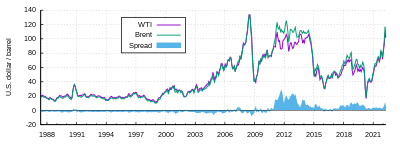West Texas Intermediate

West Texas Intermediate (WTI), also known as Texas light sweet, is a grade of crude oil used as a benchmark in oil pricing. This grade is described as light because of its relatively low density, and sweet because of its low sulfur content. It is the underlying commodity of New York Mercantile Exchange's oil futures contracts.
The price of WTI is often referenced in news reports on oil prices, alongside the price of Brent crude from the North Sea. Other important oil markers include the Dubai Crude, Oman Crude, Urals oil and the OPEC Reference Basket. WTI is lighter and sweeter than Brent, and considerably lighter and sweeter than Dubai or Oman.[1]
Characteristics
WTI is a light crude oil, with an API gravity of around 39.6 and specific gravity of about 0.827, which is lighter than Brent crude. It contains about 0.24% sulfur thus is rated as a sweet crude oil (having less than 0.5% sulfur), sweeter than Brent which has 0.37% sulfur. WTI is refined mostly in the Midwest and Gulf Coast regions in the U.S., since it is high quality fuel and is produced within the country.
West Texas Intermediate price settlement point
Cushing, Oklahoma is a major trading hub for crude oil and has been the delivery point for crude contracts and therefore the price settlement point for West Texas Intermediate on the New York Mercantile Exchange for over three decades.[2] The town of Cushing, Oklahoma is a small, remote place with only 7,826 inhabitants (according to the 2010 Census).[3] However, it is the site of the Cushing Oil Field, which was discovered in 1912, and dominated U.S. oil production for several years. The area became a "vital transshipment point with many intersecting pipelines, storage facilities and easy access to refiners and suppliers," infrastructure which remained after the Cushing field had declined in importance. Crude oil flows "inbound to Cushing from all directions and outbound through dozens of pipelines".[4] It is in Payne County, Oklahoma, United States.
Pricing[5]
West Texas Intermediate is used as a benchmark in oil pricing. Historically, it has traded closely to Brent and the OPEC basket but currently it has been discounted against Brent crude oil. Historical price data for WTI can be found at a website by the Energy Information Administration of the Department of Energy. It is listed as WTI, Cushing, Oklahoma.[6]
Pricing anomalies
On April 13, 2007 Bloomberg reported on a Lehman Brothers study stating WTI prices were not a good barometer of world oil prices.[7] On May 24, 2007, WTI was priced at $63.58 per barrel versus $71.39 per barrel for Brent (Bloomberg). The anomaly occurred perhaps because of a temporary shortage of refining capacity. In early 2007 a large stockpile of oil at the giant Cushing, Oklahoma storage and pricing facility (mainly due to a refinery shutdown[8]) caused price to be artificially depressed at the Cushing pricing point. As stockpiles decreased, the WTI price increased to exceed the price of Brent once again.[9]
In February 2011, WTI was trading around $85/barrel while Brent was at $103/barrel. The reason most cited for this difference was that Cushing had reached capacity, due to a surplus of oil in the interior of North America. At the same time, Brent moved up in reaction to civil unrest in Egypt and across the Middle East. Since WTI-priced stockpiles at Cushing could not easily be transported to the Gulf Coast, WTI crude was unable to be arbitraged in bringing the two prices back to parity. Oil prices at coastal areas of the US were closer to Brent than to WTI. In June 2012, the Seaway Pipeline, which had been transporting oil from the Gulf Coast to Cushing, reversed its flow direction, to transport WTI-priced crude to the Gulf Coast, where it received Brent prices. The price difference persisted, however, and was large enough that some oil producers in North Dakota put their oil on tanker cars, and shipped it by rail to the Gulf and East coasts, where it received Brent prices.[10] Brent continued to trade US$10–20 higher than WTI for two years, until June 2013.[11] By July 2013, the disparity had shrunk to about US$4. By January 2014 the spread between the two has once again increased to over US$14, but was back down to US$4 by the end of 2014.
See also
References
- ^ Marius Vassiliou (2009). Historical Dictionary of the Petroleum Industry. Lanham, MD: Scarecrow Press. ISBN 0-8108-5993-9.
- ^ "Light Sweet Crude Oil Futures".
- ^ Census Viewer:Population of the City of Cushing, Oklahoma
- ^ "Light Sweet Crude Oil (WTI) Futures and Options: When the World Asks, "What's the Price of Crude Oil?" WTI is the Answer" (PDF). CME Group.
- ^ "Brent vs WTI crude oil price". Petroleumroughneck.
{{cite web}}: Cite has empty unknown parameter:|dead-url=(help) - ^ oil price
- ^ "WTI Prices Don't Reflect International Oil Market, Study Says". Bloomberg.com. 13 April 2007. Retrieved 16 April 2013.
- ^ Shenk, Mark (13 April 2007). "Crude Oil in New York Falls on Increasing Supplies in Oklahoma". Bloomberg.
- ^ "Oil holds steady as pick-up in gasoline production offsets geopolitical tensions - Forbes.com". Archived from the original on March 11, 2008.
{{cite news}}: Unknown parameter|deadurl=ignored (|url-status=suggested) (help) - ^ Energy Information Administration, Rail delivery of US Petroleum, 10 July 2013.
- ^ US Energy Information Administration, Price difference between WTI and Brent Crude oil narrowing, 28 June 2013.
External links
- U.S. Energy Information Administration Part of the U.S. Department of Energy, official source of price and other statistical information
- Interactive Chart of WTI Crude Prices Since 1946
